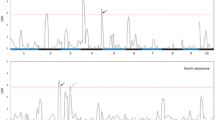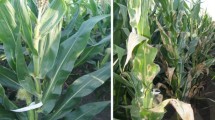Abstract
The Mediterranean corn borer or pink stem borer (MCB, Sesamia nonagrioides Lefebvre) causes important yield losses as a consequence of stalk tunneling and direct kernel damage. B73 and Mo17 are the source of the most commercial valuable maize inbred lines in temperate zones, while the intermated B73 × Mo17 (IBM) population is an invaluable source for QTL identification. However, no or few experiments have been carried out to detect QTL for corn borer resistance in the B73 × Mo17 population. The objective of this work was to locate QTL for resistance to stem tunneling and kernel damage by MCB in the IBM population. We detected a QTL for kernel damage at bin 8.05, although the effect was small and two QTL for stalk tunneling at bins 1.06 and 9.04 in which the additive effects were 4 cm, approximately. The two QTL detected for MCB resistance were close to other QTL consistently found for European corn borer (ECB, Ostrinia nubilalis Hübner) resistance, indicating mechanisms of resistance common to both pests or gene clusters controlling resistance to different plagues. The precise mapping achieved with the IBM population will facilitate the QTL pyramiding and the positional cloning of the detected QTL.
Similar content being viewed by others
References
Andersen JR, Zein I, Wenzel G, Darnhofer B, Eder J, Ouzunova M, Lübberstedt T (2008) Characterization of phenylpropanoid pathway genes within European maize (Zea mays L.) inbreds. BMC Plant Biol 2008(8):2–13
Avantaggiato G, Quaranta F, Desiderio E, Visconti V (2002) Fumonisin contamination of maize hybrids visibly damaged by Sesamia. J Sci Food Agric 83:13–18
Bernardo R (2002) Breeding for quantitative traits in plants. Stemma Press, Woodbury, Minnesota, USA
Bohn M, Schulz B, Kreps R, Klein D, Melchinger AE (2000) QTL mapping for resistance against the European corn borer (Ostrinia nubilalis H.) in early maturing European dent germplasm. Theor Appl Genet 101:907–917
Butron A, Malvar RA, Velasco P, Revilla P, Ordas A (1998) Defense mechanisms of maize against pink stem borer. Crop Sci 38:1159–1163
Butron A, Malvar RA, Cartea ME, Ordas A, Velasco P (1999a) Resistance of maize inbreds to pink stem borer. Crop Sci 39:102–107
Butron A, Malvar RA, Velasco P, Vales MI, Ordas A (1999b) Combining abilities for maize stem antibiosis, yield loss, and yield under infestation and non infestation with pink stem borer. Crop Sci 39:691–696
Cardinal AJ, Lee M (2005) Genetic relationships between resistance to stalk-tunneling by the European corn borer and cell-wall components in maize population B73 × B52. Theor Appl Genet 111:1–7
Cardinal AJ, Lee M, Sharopova N, Woodman WL, Long MJ (2001) Genetic mapping and analysis of quantitative trait loci in maize for resistance to stalk tunnelling by the European corn borer. Crop Sci 41:835–845
Cartea ME, Malvar RA, Vales MI, Butron A, Ordas A (2001) Inheritance of resistance to ear damage caused by Sesamia nonagrioides (Lepidoptera: Noctuidae) in maize. J Econ Entomol 94:277–283
Cordero A, Malvar RA, Butron A, Revilla P, Velasco P, Ordas A (1998) Population dynamics and life-cycle of corn borers in south Atlantic European coast. Maydica 43:5–12
Dekkers JCM, Hospital F (2002) The use of molecular genetics in the improvement of agricultural populations. Nature Rev Genet 3:22–32
Eizaguirre M, Albajes R (1992) Diapause induction in the stem corn borer Sesamia nonagrioides (Lepidoptera, Noctuidae). Entomol Gen 17:277–283
Europabio (2002) EuropaBio′s biotechnology information kit. Genetically modified maize. http://www.europabio.be/module_10.htm
Goodman MM (2005) Broadening de US maize germplasm base. Maydica 50:203–214
Guillaumie S, San-Clemente H, Deswarte C, Martinez Y, Lapierre C, Murigneux A, Barriere Y, Pichon M, Goffner D (2007) Maizewall. Database and developmental gene expression profiling of cell wall biosynthesis and assembly in maize. Plant Physiol 143:339–363
Hallauer AR, Miranda JB (1988) Quantitative genetics in maize breeding. Iowa State University Press, Ames, Iowa, USA
Holland JB (2007) Genetic architecture of complex traits in plants. Curr Opin Plant Biol 10:156–161
Hospital F, Moreau L, Lacoudre F, Charcosset A, Gallais A (1997) More on the efficiency of marker-assisted selection. Theor Appl Genet 95:1181–1189
Jampatong C, McMullen MD, Barry BD, Darrah LL, Byrne PF, Kross H (2002) Quantitative trait loci for first- and second-generation European corn borer resistance from the maize inbred line Mo47. Crop Sci 42:584–593
Krakowsky MD, Brinkman MJ, Woodman-Clikeman WL, Lee M (2002) Genetic component of resistance to stalk tunnelling by the European corn borer in maize. Crop Sci 42:1309–1315
Krakowsky MD, Lee M, Woodman-Clikeman WL, Long MJ, Sharopova N (2004) QTL mapping of resistance to stalk tunnelling by the European corn borer in RILs of maize population B73 × De811. Crop Sci 44:274–282
Krakowsky MD, Lee M, Holland JB (2007) Genotypic correlation and multivariate QTL analyses for cell wall components and resistance to stalk tunnelling by the European corn borer in maize. Crop Sci 47:485–490
Lee M, Sharopova N, Beavis WD, Grant D, Katt M, Blair D, Hallauer A (2002) Expanding the genetic map of maize with the intermated B73 × Mo17 (IBM) population. Plant Mol Biol 48:453–461
Lu H, Bernardo R (2001) Molecular marker diversity among current and historical maize inbreds. Theor Appl Genet 103:613–617
Malvar RA, Butron A, Cartea ME, Ordas A (1996) Ear resistance to pink stem borer in maize inbred lines. In: XVIIth Conference of genetics, biotechnology and breeding of maize and sorghum, Thesaaloniki, Greece, p 96
Mika A, Buck F, Lüthje S (2008) Membrane-bound class II peroxidases: identification, biochemical properties and sequence analysis of isoenzymes purified from maize (Zea mays L.) roots. J Proteomics 71:412–424
Mikel MA, Dudley JW (2006) Evolution of North American dent corn from public to proprietary germplasm. Crop Sci 46:1193–1205
Mode CJ, Robinson HF (1959) Pleiotropism and genetic variance and covariance. Biometrics 15:518–537
Ordas A (1991) Heterosis in crosses between American and Spanish populations of maize. Crop Sci 31:931–935
Papst C, Bohn M, Utz HF, Melchinger AE, Klein D, Elder J (2004) QTL mapping for European corn borer and forage quality traits of testcross progenies in early-maturing European maize (Zea mays L.) germplasm. Theor Appl Genet 108:1545–1554
Passardi F, Longet D, Penel C, Dunand C (2004) The class III peroxidase multigenic family in rice and its evolution in land plants. Phytochemistry 65:1879–1893
Reif JC, Hallauer AR, Melchinger AE (2005) Heterosis and heterotic patterns in maize. Maydica 50:215–223
Santiago R, Butron A, Arnason JT, Reid LM, Souto XC, Malvar RA (2006a) Putative role of pith cell wall phenylpropanoids in Sesamia nonagrioides (Lepidoptera: Noctuidae) resistance. J Agric Food Chem 54:2274–2279
Santiago R, Butron A, Reid LM, Arnason JT, Sandoya G, Souto XC, Malvar RA (2006b) Diferulate content of maize sheaths is associated with resistance to the Mediterranean corn borer Sesamia nonagrioides (Lepidoptera: Noctuidae). J Agric Food Chem 54:9140–9144
SAS Institute (2003) Version 9.1.3. SAS Institute, Cary, NC
Schon CC, Lee M, Melchinger AE, Guthrie WD, Woodman WD (1993) Mapping and characterization of quantitative trait loci affecting resistance against second-generation European corn borer in maize with the aid of RFLPs. Heredity 70:648–659
Sneller CH, Mather DE, Crepieux S (2009) Analytical approaches and population types for finding and utilizing QTL in complex plant populations. Crop Sci 49:363–380
Soengas P, Butron A, Revilla P, Ordas A, Malvar RA (2004) Performance of crosses among flint maize populations under infestation by Sesamia nonagrioides (Lepidoptera: Noctuidae). J Econ Entomol 97:1438–1443
Thome CR, Smith ME, Mihm JA (1992) Leaf-feeding resistance to multiple insect species in a maize diallel. Crop Sci 32:1460–1463
Tuberosa R, Salvi S, Giuliani S, Sanguineti MC, Belloti M, Conti S, Landi P (2007) Genome-wide approaches to investigate and improve maize response to drought. Crop Sci 47:S120–S141
Utz HF, Melchinger AE (1996) PLABQTL. A computer program to map QTL. J Quant Trait Loci 2:1
Utz HF, Melchinger AE (2003) A computer program to map QTL. http://www.uni-hohenheim.de/~ipspwww/soft.html
Utz HF, Melchinger AE, Schon CC (2000) Bias and sampling error of the estimated proportion of genotypic variance explained by quantitative trait loci determined from experimental data in maize using cross validation with independent samples. Genetics 154:1839–1849
Velasco P, Malvar RA, Revilla P, Butron A, Ordas A (1999) Ear resistance of sweet corn populations to Sesamia nonagrioides (Lepidoptera: Noctuidae) and Ostrinia nubilalis (Lepidoptera: Pyralidae). J Econ Entomol 92:732–739
Velasco P, Revilla P, Monetti L, Butron A, Ordas A, Malvar RA (2007) Corn borers (Lepidoptera: Noctuidae, Crambidae) in Northwestern Spain: population dynamics and distribution. Maydica 52:195–203
Zeng Z (1994) Precision mapping of quantitative trait loci. Genetics 136:1457–1468
Acknowledgments
This research was supported by the National Plan for Research and Development of Spain (Project Cod. AGL2006-13140). B Ordas and R Santiago acknowledge a contract from the Spanish National Research Council (I3P Program) and G Sandoya acknowledges a fellowship from the Ministry of Education and Science (Spain).
Author information
Authors and Affiliations
Corresponding author
Additional information
Communicated by M. Bohn.
Electronic supplementary material
Below is the link to the electronic supplementary material.
Rights and permissions
About this article
Cite this article
Ordas, B., Malvar, R.A., Santiago, R. et al. Mapping of QTL for resistance to the Mediterranean corn borer attack using the intermated B73 × Mo17 (IBM) population of maize. Theor Appl Genet 119, 1451–1459 (2009). https://doi.org/10.1007/s00122-009-1147-6
Received:
Accepted:
Published:
Issue Date:
DOI: https://doi.org/10.1007/s00122-009-1147-6




